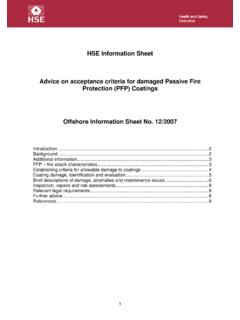Transcription of Varroa Mite–Sampling and Monitoring Infestation Levels
1 INTRODUCTION Varroa mites, Varroa destructor, ( Varroa ) are the most serious threat to honey bees. Varroa are relatively large external parasites that feed on the body fluids of adult and developing honey bees. While feeding on bees, Varroa cause physical damage, weaken bees and transmit a variety of pathogens, particularly viruses. In almost all cases, Varroa infestations of honey bee colonies will result in the death of the entire colony. It is crucial that beekeepers manage the health of their honey bee colonies by suppressing the population of Varroa in all of them throughout the beekeeping season. This usually requires chemical treatments. It is also essential for beekeepers to monitor the severity of Varroa infestations to ensure the Levels of Infestation are kept below damaging thresholds.
2 It is also important to be able to quantify the level of Varroa Infestation in a colony. There are three different methods of sampling for Varroa in honey bee colonies: 1. Alcohol wash 2. Ether roll 3. Sticky boards Note: In the past Varroa was known by the species name Varroa jacobsoni. Unless, specified otherwise in this document, the physical descriptions of Varroa refer to the adult female stage of the Varroa mite. DETECTION AND DIAGNOSIS Varroa are typically concentrated in the brood nest of the honey bee colony and present in the brood cells. In severe infestations Varroa mites may be observed on the surface of worker bees (figure 1). Varroa mites are darkish red, oval in shape, to mm long x to mm wide with eight small legs at the front the body.
3 Since Varroa mites are about the size of and shape of a sesame seed they can be seen with the naked eye (figure 2). Varroa Mite Sampling and Monitoring Infestation Levels APRIL 2012 Figure 1. Honey bees infested with Varroa mites. Note the red ovals on the body of the bees. Figure 2. Close up view of Varroa mites. Figure 3. Honey bee infected with deformed wing virus. High Levels of Infestation may weaken a colony. Many worker bees, seen crawling in or outside the entrance of the colony, will exhibit symptoms of viruses, such as deformed wings. This is not how you want to detect Varroa in a colony as the damage to the colony at this stage is severe (figure 3). Methods for collecting bees for samples Two of the methods (alcohol wash and ether roll) for detecting and quantifying Varroa from honey bee colonies require the beekeeper to obtain a sample of live bees so that the Varroa mites can be collected directly from the bodies of the bees.
4 In this way the beekeeper can estimate the level of Infestation for the entire colony. Collect a sample of bees from the brood chamber. This is where the highest number of Varroa mites will be present. Since the bees in the sample will be killed, beekeepers must be particularly careful not to include the colony s queen in the sample. Beekeepers may locate and then cage the queen first. For a representative sample of the colony, collect bees from at least three different frames. There are two different ways of collecting bees from the colony Beekeepers may shake the bees directly off of the frame into a pan where the bees can then be scooped into a container (figure 4). Beekeepers may also collect bees directly from the frame by gently running the container over the surface of the frame, with the frame tilted downwards at 30 so that the bees fall into the container (figure 5).
5 ALCOHOL WASH METHOD 1. Collect half a cup of worker bees (approximately 300 bees) from the brood chamber of the colony. Place the bees inside a well sealed container and add alcohol (at 70%). 2. Ensure the alcohol completely covers the honey bees in the container, level approximately 2 cm above the surface of the bees. 3. Vigorously shake the sample in the container for two minutes to dislodge the Varroa from the bodies of the worker bees (figure 6). 4. Pour the mixture of dead bees, mites and alcohol onto a 1/8 inch hardware cloth, mesh wire screen over a receiving container or pan to filter out the honey bees from the smaller Varroa . The container or pan should be light coloured or clear so the Varroa can be easily seen. 5. Count the Varroa mites in the container or pan.
6 Divide by three to obtain the percentage of Infestation . For example, if you have 3 Varroa in a sample of 300 bees then 3/300 = 1/100 or 1% Infestation . 6. Dispose of the dead bees and rinse the container with water to remove the mites between samples. Handheld, easy to use, commercially manufactured mite shaker devices that give effective and fast results are 2 Figure 4. Scooping bees from collecting pan. Figure 5. Collecting bees from the surface of the frame. available. Follow the directions given with the shaking apparatus. Contact your local bee supply outlet for availability. Materials required: pan, cup, cup, 1/8 inch hardware cloth or wire mesh, pan or bucket, alcohol, water, notebook and mite shaker. ETHER ROLL METHOD 1. Collect half a cup of worker bees (approximately 300 bees) from the brood chamber of the colony.
7 2. Once the sample is collected beekeepers should move at least 10 feet away from honey bee colonies because ether can agitate the bees. Place the bees inside a well sealed quart glass jar (mason jar works quite well) and spray engine starter fluid into the container three times (figure 7). 3. Shake the jar (up and down and back and forth) for up to one minute. Roll the jar along the side several times. 4. Count the Varroa mites that stick to the side of the jar and under the lid. Record the result. Mark a vertical line along the jar to keep track of where the counting begins and ends. 5. Dispose the dead bees and rinse the container with water to remove the mites between samples. Materials required: 1 quart glass mason jar; dishwashing gloves; engine starter fluid spray; permanent marker; a container of water; record book and pen.
8 STICKY BOARD METHOD 1. Mark a piece of heavy paper (40 x cm) with a grid to facilitate the counting process. A letter size folder is an excellent sticky board. Open and flatten the file, then cut approximately 5 cm off one end. Mark the colony number on the tab at the other end. 2. Coat the paper evenly with Tangle-Trap Insect Trap Coating (paste formula). A combination of Crisco and vegetable oil or petroleum jelly can also be used to coat the paper. 3 Figure 6. A commercially available mite shaking device for the alcohol wash. Figure 7. Glass jar used for the ether roll. 3. Insert the sticky board beneath the brood chamber, ideally under a screen bottom board (using 1/8 inch hardware cloth or wire mesh). If there is no screen bottom board then place the hardware cloth or wire mesh directly over the sticky board.
9 Placing each sticky paper on a serving tray is an excellent way to transport the sticky boards to and from the bee yard. The trays can then be stacked alternatively in a box (figure 8). 4. Boards should be collected after a period of 24, 48 or 72 hours. Three days is better than one because the average mite fall of three days is more reliable. Divide the duration by a 24 hour period. For example, a mite drop of 36 over 72 hours should be divided by 3 therefore 12 mites / 24 hours. Record results. New boards should be used for different samples (figure 9). Materials required: Cardboard paper, sticky material, screened bottom board, magnifying glass, notebook and pen. Table 1. Comparison of Monitoring methods Monitoring Method Advantages Disadvantages Ether Roll Results are obtained in one visit to the beeyard.
10 Results are available immediately. A standardized number of bees (300) is ideal for comparison between colonies. A small sample of bees are killed Alcohol Wash Results are obtained in one visit to the beeyard. Results are available immediately. A standardized number of bees (300) is ideal for comparison between colonies A small sample of bees are killed Sticky Board No bees are killed. Can be used to monitor mite drop during treatments. Will detect mites at very low Levels . Must return to the beeyard to obtain sample Results can be variable based on the size of the colony and the behaviour of the bees (grooming and hygienic behaviour) Does not assess the level of mites still present on the bees. Although there may be large numbers of mites dropping in a bottom board sample, this may only represent a much larger population that is still left on the bees 4 Figure 8.







